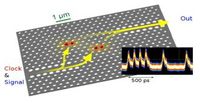Context
There is a pressing need for these devices for ultra-high bandwidth data links in server farms, optical storage networks and on-board internet/entertainment systems, where demand is driving the data bandwidth and technology integration level rapidly upwards. Next generation telecom systems will also benefit from these devices for OTDM and optical packet switching. Their high-speed and bandwidth, together with their ultra-low power consumption and extreme compactness, also make them a very promising technology for seamless cross-chip and off-chip data links for CMOS electronics. This approach has all the hallmarks of a highly disruptive technology with the potential to place Europe at the forefront of photonics.
Goals
COPERNICUS will develop the photonic crystal (PhC) technology and the key devices for integrated PhC receiver chips supporting 100 Gb/s data rates. Key functions to be developed, all of them on a PhC chip, are the following :
- PhC based wavelength drop filters matching the requirements for WDM in terms of crosstalk rejection, bandwidth and frequency spacing for 25 Gb/s 4-channnels WDM demultiplexing

- All optical gates (AOGs) featuring low power consumption and ultra-fast response for demultiplexing at 100 Gb/s
-
 Photodetectors with large bandwidth and high responsivity integrated on the PhC chip
Photodetectors with large bandwidth and high responsivity integrated on the PhC chip - Single mode optical "circuitry" integrated on the chip to deliver pulses to the different subdevices with well controlled timing
The WDM receiver targets medium term applications and will demonstrate the wavelength drop filter and integrated photodetector technologies. The WDM receiver will demultiplex four optical channels with bit rates of 25 Gb/s. It will be packaged and its performance assessed for application to high-bandwidth data links in server farms.
The OTDM receiver will target long term applications and will demonstrate the all-optical gate and key technologies for the integration of photonic crystal circuits (timing, dispersion management, routing, etc.). The AOG will be assessed as a single gate and in cascaded configurations with other gates.
Main results
The AOG switches have shown very fast switching speeds, around 10 ps. Those results were achieved with either two-port AOGs or three-port AOGs. The all-optical routing capabilities of such switches are controlled with very low power commands.
- The AOG switches were tested by FOTON as power limiters at 10 and 20 Gbps for noise reduction applications. A power penalty reduction of 4.5 dB at 10-9 BER was successfully demonstrated with only 1 mW of coupled peak power.
- By inserting an AOG in an analogue microwave-photonic link and coupling it with a 10 Gbps pulsed optical source, TSA brought out the capacity of all-optical sampling of high-frequency optical signals. This technique of mixing process also demonstrated the transfer of a microwave signal (at 10 GHz, only limited by test equipment) from one input signal to a dropped signal. Based on this capability, several advanced concepts for optical processing were derived, and could be evaluated with cascaded AOGs.
- AOG cavities can also greatly enhance non-linear optical effects. FOTON demonstrated high bit rate wavelength conversion in 2- and 3-port AOGs.
- Using the Four-Wave Mixing effect in a PhC waveguide, FOTON characterized the capability of wavelength conversion at 10 Gbps with a NRZ signal. The promising result has received avourable feedback from the scientific community. Wavelength conversion is an alternative option to OTDM for node network management.
- Using Second Harmonic Generation, FOTON also demonstrated the all-optical monitoring of signal-to-noise ratio and chromatic dispersion of a high bit rate signal (42.5 Gbps RZ), with high efficiency inside the nanosize of the PhC waveguide.
Foton activities in the COPERNICUS project were highlighted through a video.
Scientific Production
 see in HAL
see in HAL
Partners
Thales TRT - LPN - University of Nottingham - Universita degli studi di Ferrara - Thales TSA - DTU - U²T Photonics
Coordinator
Thales TRT (Alfredo De Rossi)
(person in charge at Foton : Mathilde GAY)
Funding
Europe (STREP - ICT 2009.3.8)
Voir en ligne :
![]() official website
official website

































